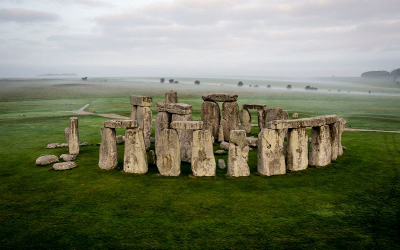|
New Stonehenge Theory: It's a Solar Calendar
March 2, 2022
Yet another archaeologist has revealed yet another theory about the purpose of Stonehenge, the collection of large ancient stones on England's Salisbury Plain. This latest theory is that the stones functioned as a solar calendar. That is the argument put forward by Professor Timothy Darvill (right) of Bournemouth University, who posits that each of the 30 sarsen stones (the ones in the outer circle) signified a day in a month and that the ancient Britons tracked their solar year as a progression of three 10-day weeks. The five Trilithons (the very large stones in the inner circle) signified a five-day month that served to make up the extra time, so that the ancient calendar-watchers arrived at 365 days in one revolution around the Sun. The actual solar year is about one-quarter of a day longer than 365, and this is why scientists created the leap day and leap year. Stonehenge has four Station Stones that sit outside the Sarsen Circle, and Darvill's theory is that those four stones were used to total up four years, so that ancient people could mark a leap day. Many theories through the years have posited that Stonehenge was some sort of calendar, marking the time of the solstices, when sunlight shone directly through a specific trilithon. Darvill's is the first theory to expand on that premise and incorporate more modern research, which showed that the sarsen stones came from the same part of the British Isles and were added at roughly the same time in the overall construction of the monument. Such a solar calendar was known to have been used in Ancient Egypt; the people of that civilization termed it the Civil Calendar. Other ancient cultures, including Mesopotamia, used similar ways to track the solar year. Darvill's findings, which appear in a recent issue of the journal Antiquity, suggest that cultural exchange between such civilizations led to the development of similar timekeeping systems. Darvill and a team of archaeologists have been working in and around Stonehenge for more than a decade. In a 2020 study, they reported evidence suggesting that the sarsen stones came from West Woods, just 10 miles north of Stonehenge. Just one year before that, another team of archaeologists identified that the bluestones came from Welsh quarries 180 miles away. |
Social Studies for Kids |
Social Studies for Kids
copyright 2002–2024
David White






